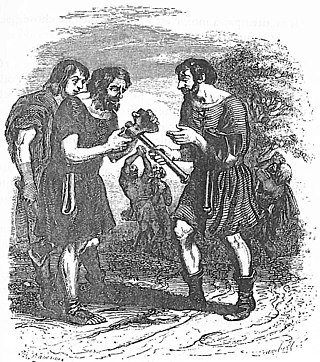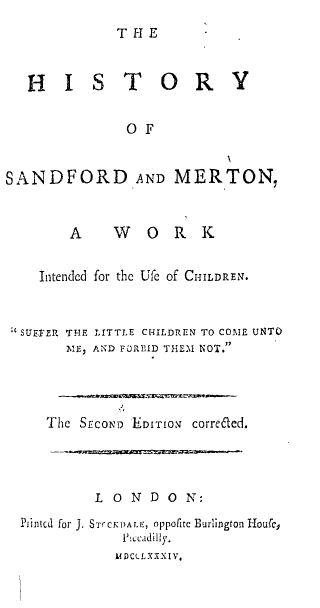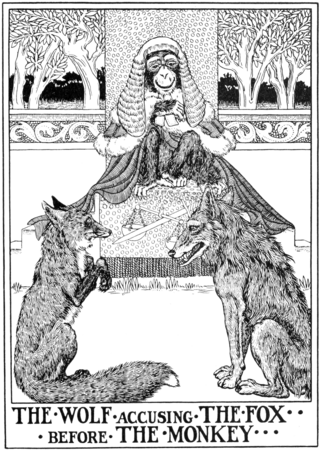
Fable is a literary genre defined as a succinct fictional story, in prose or verse, that features animals, legendary creatures, plants, inanimate objects, or forces of nature that are anthropomorphized, and that illustrates or leads to a particular moral lesson, which may at the end be added explicitly as a concise maxim or saying.

A parable is a succinct, didactic story, in prose or verse, that illustrates one or more instructive lessons or principles. It differs from a fable in that fables employ animals, plants, inanimate objects, or forces of nature as characters, whereas parables have human characters. A parable is a type of metaphorical analogy.

The Panchatantra is an ancient Indian collection of interrelated animal fables in Sanskrit verse and prose, arranged within a frame story. The surviving work is dated to about 300 CE, but the fables are likely much more ancient. The text's author is unknown, but it has been attributed to Vishnu Sharma in some recensions and Vasubhaga in others, both of which may be fictitious pen names. It is likely a Hindu text, and based on older oral traditions with "animal fables that are as old as we are able to imagine".

Aesop's Fables, or the Aesopica, is a collection of fables credited to Aesop, a slave and storyteller who lived in ancient Greece between 620 and 564 BCE. Of varied and unclear origins, the stories associated with his name have descended to modern times through a number of sources and continue to be reinterpreted in different verbal registers and in popular as well as artistic media.

The Boy Who Cried Wolf is one of Aesop's Fables, numbered 210 in the Perry Index. From it is derived the English idiom "to cry wolf", defined as "to give a false alarm" in Brewer's Dictionary of Phrase and Fable and glossed by the Oxford English Dictionary as meaning to make false claims, with the result that subsequent true claims are disbelieved.
An apologue or apolog is a brief fable or allegorical story with pointed or exaggerated details, meant to serve as a pleasant vehicle for a moral doctrine or to convey a useful lesson without stating it explicitly. Unlike a fable, the moral is more important than the narrative details. As with the parable, the apologue is a tool of rhetorical argument used to convince or persuade.

"The Tortoise and the Hare" is one of Aesop's Fables and is numbered 226 in the Perry Index. The account of a race between unequal partners has attracted conflicting interpretations. The fable itself is a variant of a common folktale theme in which ingenuity and trickery are employed to overcome a stronger opponent.
The Belly and the Members is one of Aesop's Fables and is numbered 130 in the Perry Index. It has been interpreted in varying political contexts over the centuries.

The Honest Woodcutter, also known as Mercury and the Woodman and The Golden Axe, is one of Aesop's Fables, numbered 173 in the Perry Index. It serves as a cautionary tale on the need for cultivating honesty, even at the price of self-interest. It is also classified as Aarne-Thompson 729: The Axe falls into the Stream.

A bedtime story is a traditional form of storytelling, where a story is told to a child at bedtime to prepare the child for sleep. The bedtime story has long been considered "a definite institution in many families".

The Dog and Its Reflection is one of Aesop's Fables and is numbered 133 in the Perry Index. The Greek language original was retold in Latin and in this way was spread across Europe, teaching the lesson to be contented with what one has and not to relinquish substance for shadow. There also exist Indian variants of the story. The morals at the end of the fable have provided both English and French with proverbs and the story has been applied to a variety of social situations.
Traditional stories, or stories about traditions, differ from both fiction and nonfiction in that the importance of transmitting the story's worldview is generally understood to transcend an immediate need to establish its categorization as imaginary or factual. In the academic circles of literature, religion, history, and anthropology, categories of traditional story are important terminology to identify and interpret stories more precisely. Some stories belong in multiple categories and some stories do not fit into any category.

The History of Sandford and Merton (1783–89) was a best-selling children's book written by Thomas Day. He began it as a contribution to Richard Lovell and Honora Sneyd Edgeworth's Harry and Lucy, a collection of short stories for children that Maria Edgeworth continued some years after her stepmother died. He eventually expanded his original short story into the first volume of The History of Sandford and Merton, which was published anonymously in 1783; two further volumes subsequently followed in 1786 and 1789. The book was wildly successful and was reprinted until the end of the nineteenth century. It retained enough popularity or invoked enough nostalgia at the end of the nineteenth century to inspire a satire, The New History of Sandford and Merton, whose preface proudly announces that it will "teach you what to don't".

The Tortoise and the Birds is a fable of probable folk origin, early versions of which are found in both India and Greece. There are also African variants. The moral lessons to be learned from these differ and depend on the context in which they are told.

An animal tale or beast fable generally consists of a short story or poem in which animals talk. They may exhibit other anthropomorphic qualities as well, such as living in a human-like society. It is a traditional form of allegorical writing.

Talking animals are a common element in mythology and folk tales, children's literature, and modern comic books and animated cartoons. Fictional talking animals often are anthropomorphic, possessing human-like qualities. Whether they are realistic animals or fantastical ones, talking animals serve a wide range of uses in literature, from teaching morality to providing social commentary. Realistic talking animals are often found in fables, religious texts, indigenous texts, wilderness coming of age stories, naturalist fiction, animal autobiography, animal satire, and in works featuring pets and domesticated animals. Conversely, fantastical and more anthropomorphic animals are often found in the fairy tale, science fiction, toy story, and fantasy genres.
The Bear and the Gardener is a fable originating in the ancient Indian text Panchatantra that warns against making foolish friendships. There are several variant versions, both literary and oral, across the world and its folk elements are classed as Aarne-Thompson-Uther type 1586. The La Fontaine version has been taken as demonstrating various philosophical lessons.

The Frog and the Mouse is one of Aesop's Fables and exists in several versions. It is numbered 384 in the Perry Index. There are also Eastern versions of uncertain origin which are classified as Aarne-Thompson type 278, concerning unnatural relationships. The stories make the point that the treacherous are destroyed by their own actions.

The Tortoise & the Hare is a 2013 wordless picture book of Aesop's classic fable and is illustrated by Jerry Pinkney. It is about a tortoise and a hare that compete in a foot race with the tortoise surprisingly winning.

The Moon and her Mother is an ancient Greek fable doubtfully attributed to Aesop. It is number 468 in the Perry Index, and in Laura Gibbs's inclusive collection it is listed as number 16 in the Vernon Jones index (1912).















